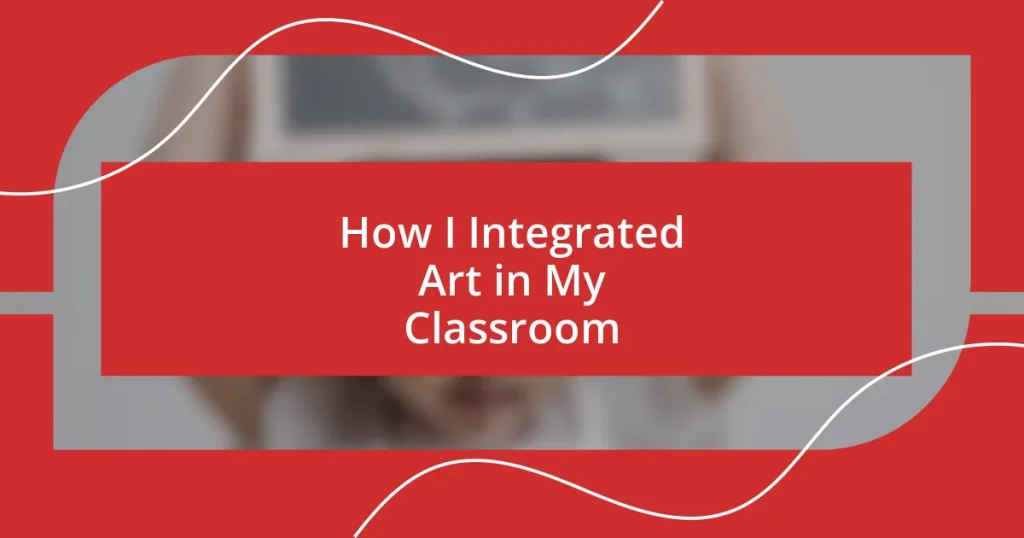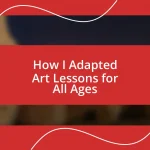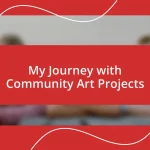Key takeaways:
- Integrating art enhances student engagement, critical thinking, collaboration, and emotional expression by allowing them to creatively connect with various subjects.
- Identifying art opportunities can occur through cross-disciplinary links, student interests, and relevant themes, fostering an environment that encourages creativity in the classroom.
- Showcasing student artwork and reflecting on integration outcomes promotes confidence, self-exploration, and emotional development, reinforcing the transformative power of art in education.
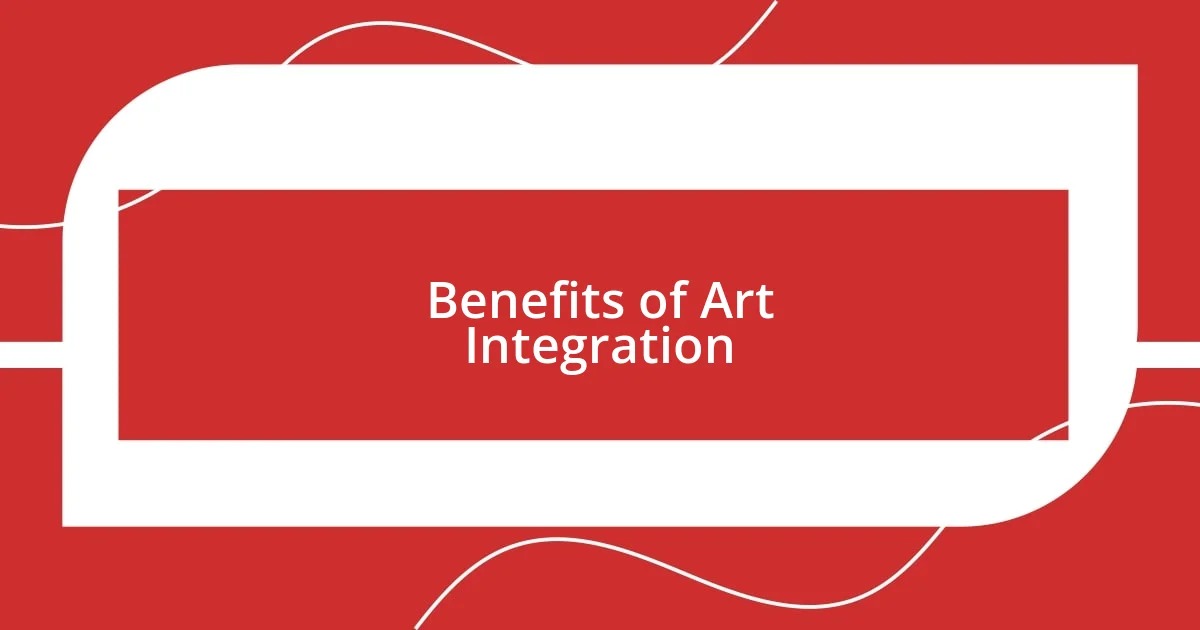
Benefits of Art Integration
Integrating art into the classroom can significantly enhance students’ engagement and motivation. I remember a project where my students had to create visual art pieces representing historical figures they were studying. Their excitement and enthusiasm were palpable; they approached the task not just as an assignment but as an opportunity to express themselves creatively, and it sparked a deeper interest in history.
One of the most profound benefits I’ve observed is the development of critical thinking skills. When students create art, they are not just following instructions; they’re making choices and solving problems. I often see them grappling with decisions about color, form, and message. Doesn’t it make sense that this practice of decision-making translates into other academic areas?
Additionally, art integration fosters collaboration and communication among students. I had a mixed group working on a mural project, and it was beautiful to see the collaboration unfold. They had to listen to each other’s ideas, negotiate roles, and support one another’s visions. This process not only strengthened their relationships but also built a sense of community in the classroom, reminding us all that education is about connection, not just content.
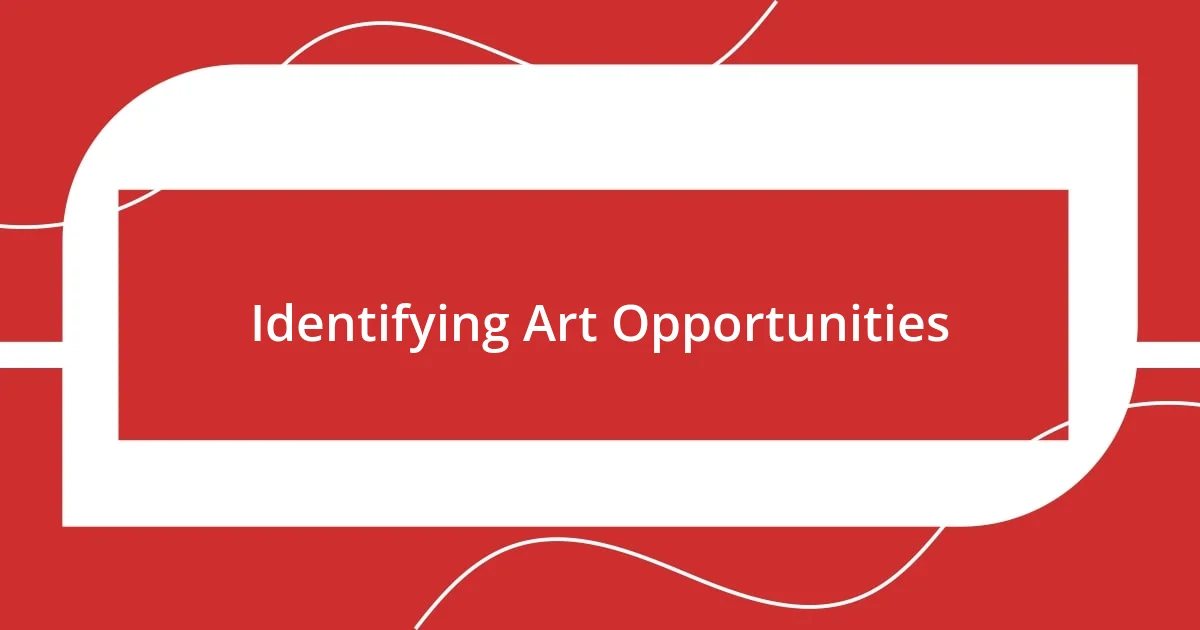
Identifying Art Opportunities
When I started looking for ways to integrate art into my classroom, I realized that opportunities often existed in the most unexpected places. I began to observe everyday subjects through an artistic lens, whether it was a math lesson that could benefit from geometric designs or a science unit on ecosystems that inspired a creative diorama. This transformation in my perception opened a world of possibilities, and I found myself more attuned to my students’ creative potential.
To help identify art opportunities in your classroom, consider these strategies:
- Cross-Disciplinary Links: Think about how art can enhance other subjects like math, science, or literature.
- Classroom Environment: Look around and see if there are visual elements that could be improved or represented artistically.
- Student Interests: Pay attention to what excites your students. If they’re passionate about a topic, find ways for them to express that through art.
- Current Events: Use relevant news stories as inspiration for art projects, allowing students to express their thoughts and feelings creatively.
- Seasonal Themes: Incorporate elements from holidays or seasons, sparking creativity through timely subjects.
Each approach not only allows for creativity to flourish but also builds a richer, more engaging learning experience. I remember once transforming a discussion on renewable energy into a collaborative art project, where students designed posters advocating for environmental protection. They were so inspired! It was eye-opening to witness their passion for both learning and creativity converge in such a meaningful way.
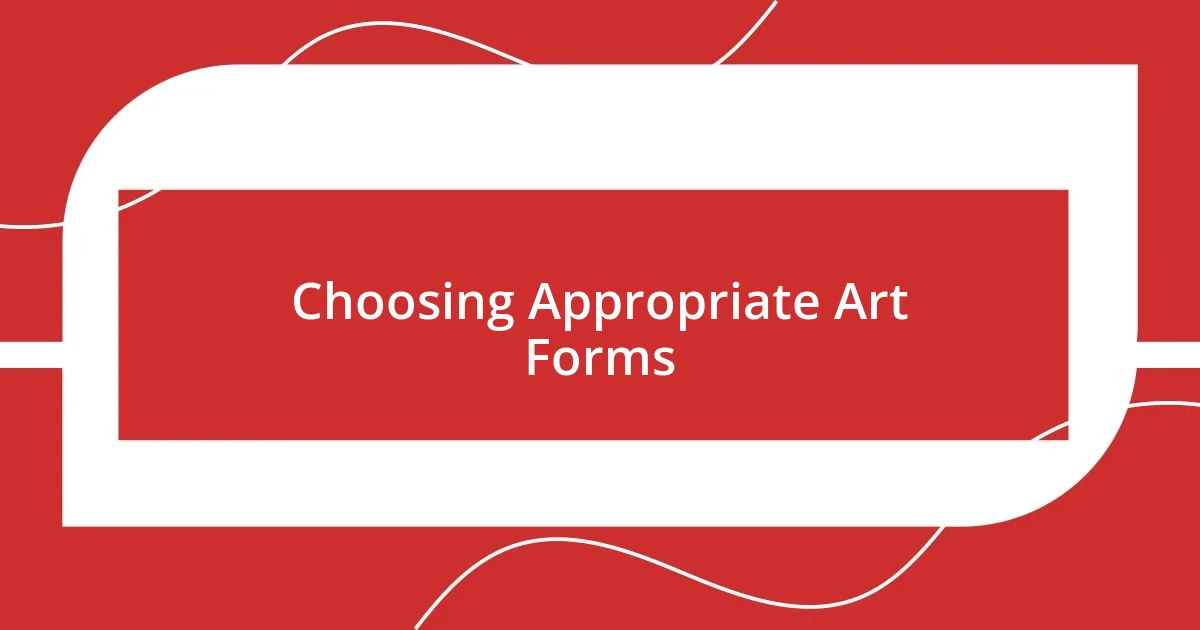
Choosing Appropriate Art Forms
Choosing the right art forms for your classroom can feel overwhelming at first, but I learned to narrow it down based on my students’ interests and the curriculum goals. For example, during a unit on poetry, I introduced visual journaling, allowing students to express complex emotions through imagery alongside their written words. It was incredible to watch them connect with the material in a way they hadn’t before, and it made poetry more tangible and relatable.
I’ve also found that different art forms resonate differently with students. In one sixth-grade project, we explored drama as a medium for understanding character motivation in literature. Students created short skits that captured the essence of their favorite book characters. The laughter, teamwork, and insights that emerged from their performances were profound. This experience reinforced my belief in the power of drama; it truly engaged those who might not connect with visual arts or traditional writing.
Finally, fostering an environment where multiple art forms coexist is key. I remember a project themed around social justice where we combined digital art, poetry, and performance. Students were encouraged to choose their preferred form, which led to a vibrant showcase that celebrated diverse voices and perspectives. It was a joy to see the richness of expression when learners were given the freedom to choose how they wanted to communicate their ideas.
| Art Form | Benefits |
|---|---|
| Visual Arts | Enhances creative expression and visual literacy. |
| Drama | Builds empathy and understanding of character perspectives. |
| Music | Encourages collaboration and emotional expression. |
| Digital Art | Integrates technology and contemporary forms of expression. |
| Literary Arts | Fosters critical thinking and narrative skills. |
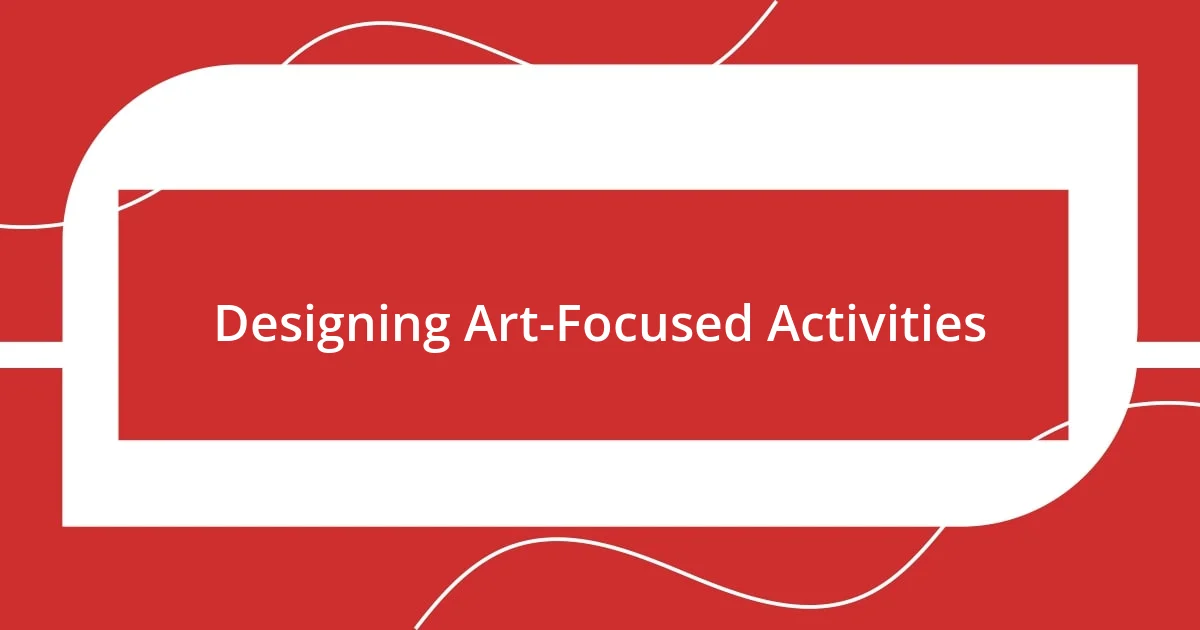
Designing Art-Focused Activities
Designing art-focused activities requires a thoughtful approach that considers both the curriculum and the unique dynamics of my classroom. One idea that really resonated with my students was creating a “living museum.” Each student researched a historical figure, then designed a backdrop and costume to represent their character. The excitement in the room was palpable during our exhibit day; I could hear their voices filled with pride as they shared their knowledge with peers. This activity not only deepened their understanding of history but also ignited their passion for storytelling through art.
Another memorable activity involved integrating art into our math lessons. One day, I challenged my students to create geometric sculptures using everyday materials like string and straws. As they constructed their pieces, I saw them not just engaging with geometric concepts but also expressing themselves individually. I remember a shy student who transformed a simple tetrahedron into a colorful bird, showcasing her creativity. It was a beautiful reflection of how art can bring otherwise abstract concepts to life, don’t you think?
Finally, I’ve found that incorporating community art projects can significantly enrich students’ learning experiences. Last year, we collaborated with a local artist to design a mural that represented our school’s values. Students worked on individual segments, which they blended seamlessly into a larger narrative. They not only collaborated on this artistic endeavor but also learned the joys and challenges of communal expression. Witnessing their faces light up as we unveiled the mural felt like a culmination of everything. How often do we get to see our students’ voices literally painted on the walls of their community? That moment reaffirmed my belief in the transformative power of art in education.
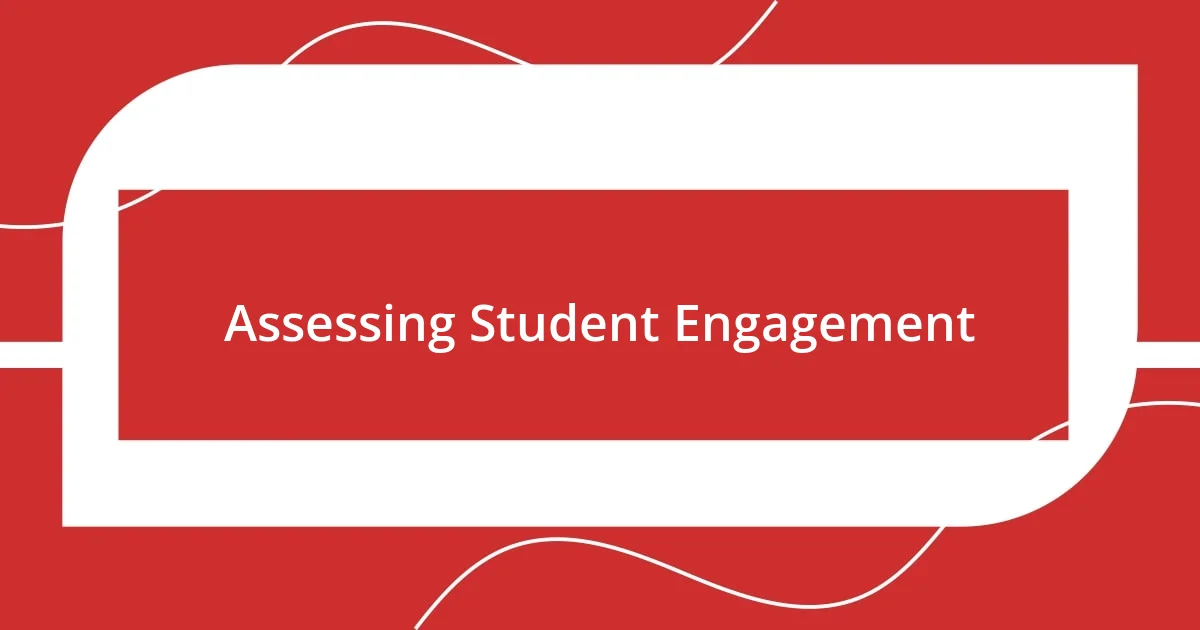
Assessing Student Engagement
Assessing student engagement is an ongoing process that extends beyond mere observation. I remember the first time I decided to gauge my students’ interest levels through a simple feedback session after an art project. Their animated responses and the twinkle in their eyes spoke volumes about their engagement. It’s fascinating how a brief conversation can reveal the depth of students’ connection to the material, don’t you think?
Another method I found effective is incorporating reflective journaling. After we completed a unit on environmental art, students shared not only their thoughts on the project but also their emotional responses to the theme. When I read their reflections, I was struck by the passion they expressed for issues they previously seemed indifferent about. Their reflections provided invaluable insights into how art can ignite awareness and concern within young minds. Isn’t it incredible how art can transform apathetic feelings into enthusiasm and advocacy?
Lastly, I’ve experimented with observation checklists during interactive art sessions. One day, while students painted murals focusing on community themes, I noted their collaborative dynamics. I could see students communicating, negotiating ideas, and making decisions together, all while expressing their creativity. It reinforced my understanding that engagement is not just about individual interest; it’s also about how students connect and work with each other. How often do we witness such powerful teamwork in other subject areas? It’s enlightening to consider the opportunities for growth that art presents for both individual expression and collaboration.
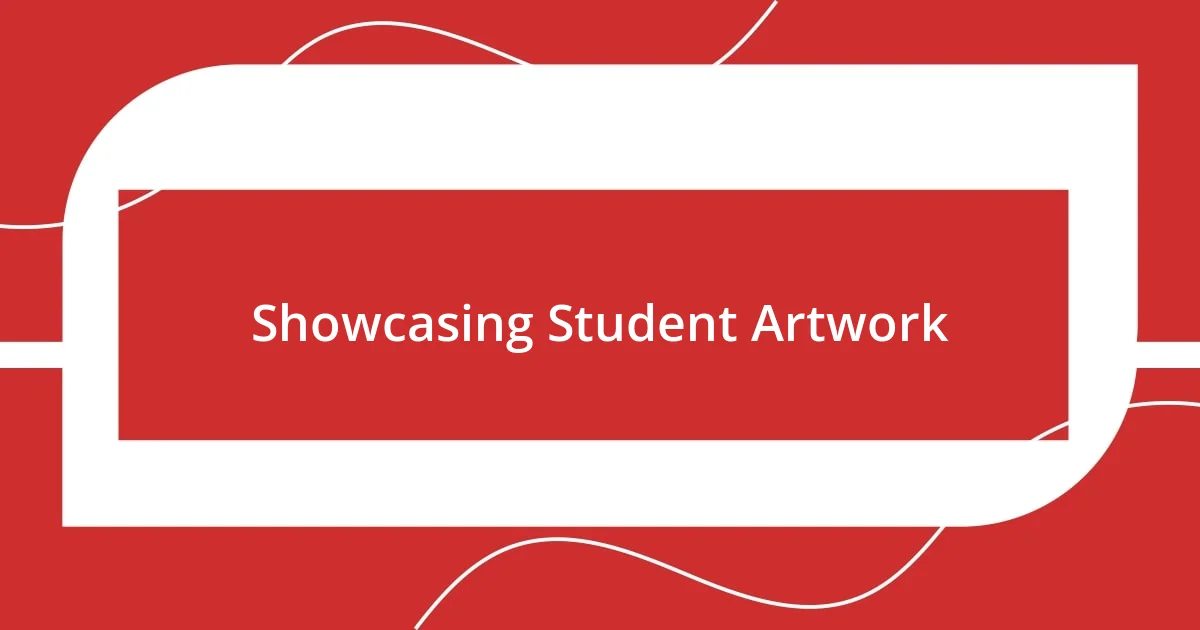
Showcasing Student Artwork
Displaying student artwork can create an atmosphere of pride and affirmation in the classroom. After we held our year-end art exhibition, I was amazed by how confidently my students presented their pieces. Watching them explain the thought and emotion behind their work felt like witnessing them step into their own identities. Isn’t it fulfilling to see young artists gain confidence just by sharing their creativity?
To elevate the experience, I started featuring a “Student Artist of the Month” in our classroom. This not only highlighted individual talents but also fostered a sense of community and belonging among my students. I remember the joy on a particular student’s face when his artwork was chosen; it was a simple pencil drawing, yet he saw it as an accomplishment that represented his unique perspective. Those moments remind me of how vital it is to acknowledge each student’s artistic journey.
I also created an online gallery where we could showcase artwork for family and friends to see. This digital display allowed students to receive feedback from within and outside our school community. I recall a parent reaching out to express how her child had blossomed through art; hearing that truly reinforced my belief in the importance of sharing student artwork. Isn’t it inspiring to think about the ripple effect of showcasing creativity? It celebrates not just the art itself, but the entire process of growth and expression that every child goes through.
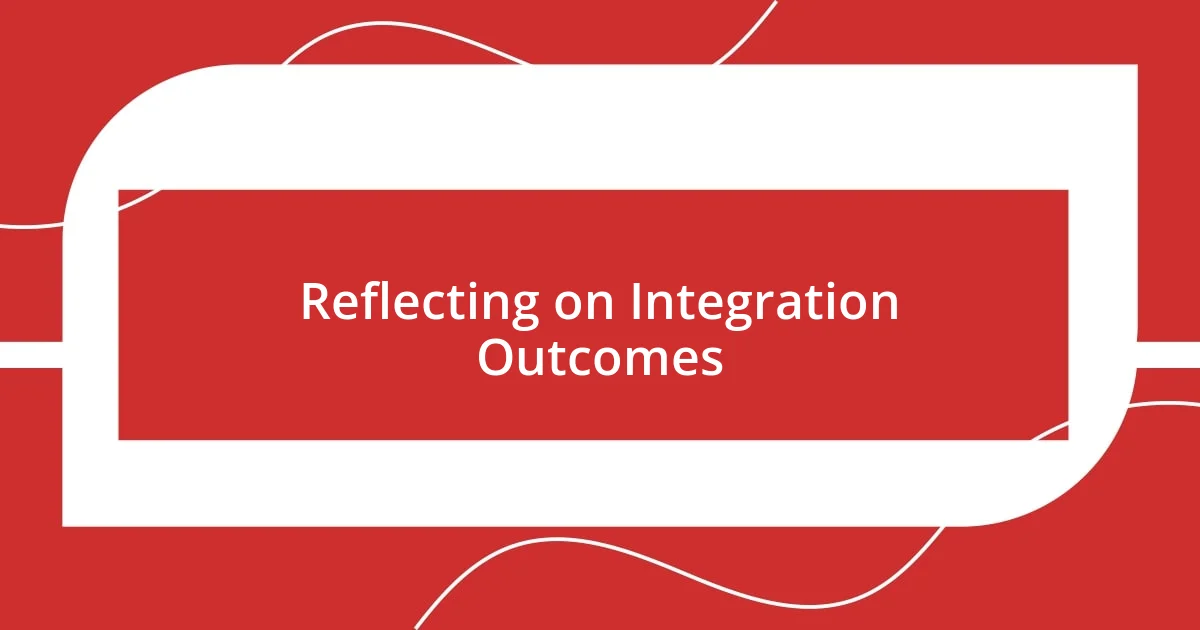
Reflecting on Integration Outcomes
Reflecting on the outcomes of integrating art into my curriculum has provided me with profound insights into student growth. One memorable instance was after a project exploring cultural identities through mixed media. Students presented works that encapsulated their backgrounds and experiences, and I was moved to see how much they were willing to share about their lives. Have you ever watched students connect deeply with their heritage? It was an affirmation of how art can serve as a powerful tool for self-exploration and expression.
The conversations that emerged following these presentations revealed not only artistic progress but also emotional development. I recall a shy student, typically reserved, who captivated everyone with her story behind a vibrant painting. Witnessing her confidence swell as peers applauded her was a heartwarming reminder of art’s capacity to give voice to those who might otherwise feel unheard. Isn’t it fascinating how creativity can unlock hidden strengths in our students?
Furthermore, assessing the integration outcomes helped me refine my approach. I implemented surveys to measure how students felt about their learning experiences with art. The overwhelmingly positive feedback illuminated areas where they found joy and passion, highlighting the importance of creativity in education. Seeing their enthusiasm documented solidified my commitment to integrating art more deeply into my teaching. It’s invigorating to think about how we can continue to cultivate such passion and engagement—what might be possible if we all leaned into creativity in our classrooms?










